
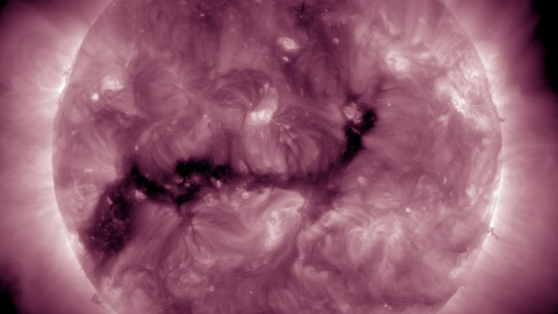
Bhubaneswar: On Jan 15, NASA has posted an image of Sun that shudders many. Is the image-reflections pose grave danger for us in Earth?
As per NASA Sun and Space report, coronoal holes on Sun are spotted again – after 8-long years. What are coronal holes exactly? (see the image below)
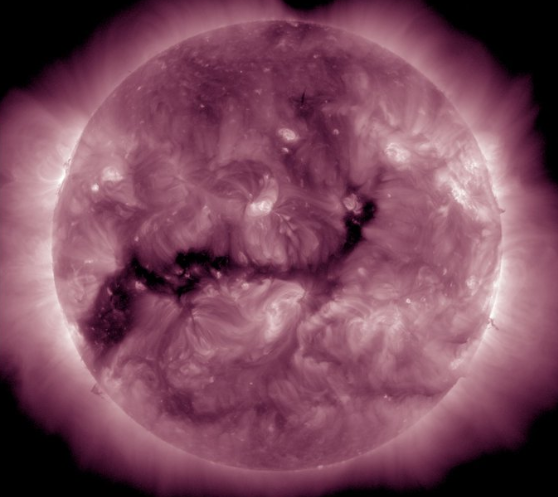
CORONAL HOLES
As per NASA, coronal holes are places where the Sun’s magnetic field opens up to space. It said, “they are like Sun’s off-ramp” – where solar materials escape at high speed. The escaping material leaves them less dense than elsewhere, making them appear darker (see the image above).
The question here is what is Sun’s Corona?
The Sun’s corona is the outermost part of the Sun’s atmosphere. The corona is usually hidden by the bright light of the Sun's surface. That makes it difficult to see without using special instruments. However, the corona can be viewed during a total solar eclipse, says the NASA report and added that the latest coronal hole has been spotted by NASA Jet Propulsion Lab.
WHAT HAPPENS WHEN CORONAL HOLES IN SUN VISIBLE?
The NASA report says something BIG. It says:
“When high speed streams from Sun’s Coronal holes reach Earth, they can occasionally (not always) cause GEOMAGNETIC STORMS, and sometimes may lead to form auroras (colourful halo seen over the north pole) – which have no effect on earth.
AURORA OR SOLAR STORM IN 2025?
According to the NASA report, the 2025 Sun calendar has the following components.
SOLAR CYCLE 25 ON!
NASA had earlier reported that we are now under the Solar Cycle 25.
WHAT IS SOLAR CYCLE: NASA defines solar cycle as the cycle that the Sun’s magnetic field goes through approximately every 11 years.
It says, “Every 11 years or so, the Sun's magnetic field completely turn over - means that the Sun's north and south poles switch places. Then it takes about another 11 years for the Sun’s north and south poles to turn over again.
The solar cycle affects activity on the surface of the Sun, such as sunspots which are caused by the Sun's magnetic fields. As the magnetic fields change, so does the amount of activity on the Sun's surface, it added.
By historical definition, Solar Cycle 1 occurred between 1755 and 1766, placing the sun's current cycle in Solar Cycle 25. (see the image below)
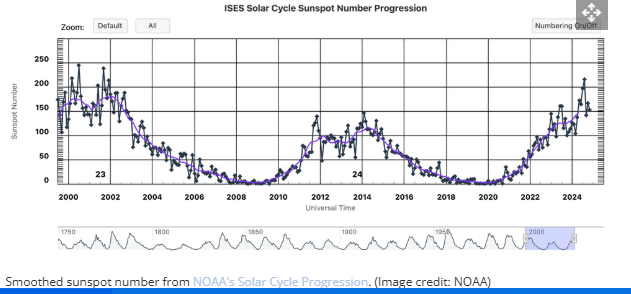
The image above shows how there is likely to be peak solar flare in 2025.
STRONGEST SUN SPOT SPOTTED IN JAN!
As per NASA release, “The Sun emitted a strong solar flare, peaking at 7:48 a.m. ET on Jan. 4, 2025. The National Oceanic and Atmospheric Administration’s Solar Ultraviolet Imager, which watches the Sun constantly, captured an image of the event. This flare is classified as an X1.8 flare. X-class denotes the most intense flares, while the number provides more information about its strength.” (Nasa image below)
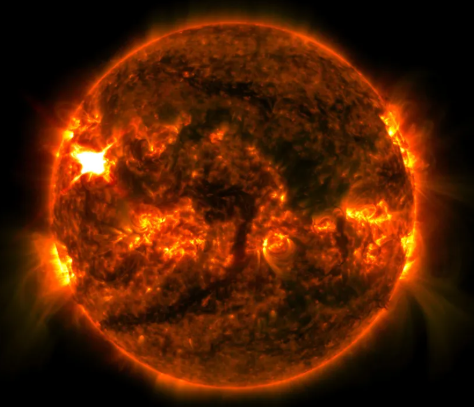
HOLD YOUR BREATH….
The strongest solar flare of Solar Cycle 25 was an X9.0 event observed on Oct. 3, 2024. But no solar storm swarmed the Earth.
However, the latest strong solar flare shows the Sun’s activity is on and the Solar cycle may not have ended.
BUT CAUTION…
NASA says, historically, large solar flares and geomagnetic storms are more common in the declining phase after solar maximum.
It cities, for instance, Solar Cycle 24 saw its largest solar flares (X13.3 and X11.9) three years after its 2014 maximum, in 2017 – the year when large coronal holes were spotted on Sun (see the image).
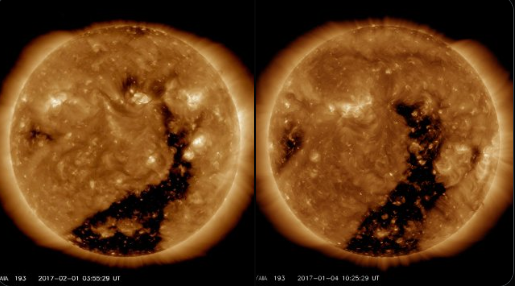
It says, “even if the solar maximum peak has passed (it may have but we wouldn't know yet), 2025 will still be within the extended period of heightened solar activity around solar maximum. While exact levels of solar activity cannot be predicted, high sunspot numbers are anticipated, along with a higher likelihood of large solar flares and Earth-directed coronal mass ejections (CMEs).”
THE BIG..
The NASA report says:
“In 2024, an extreme G5 geomagnetic storm occurred in May, followed by a strong G4 storm in October. Another strong geomagnetic storm (G4 or above) is possible in 2025. However, these events can only be predicted 1–4 days in advance, based on the detection and speed of Earth-directed CMEs.”
Reports suggest this may come around JULY 2025!
HISTORY
NASA report says, “The previous extreme geomagnetic storm happened in 2003 that caused damage to power grids in Sweden and South Africa, “ and added that in recent years – “A large portion of this struck Earth's magnetic field, producing a geomagnetic storm that interfered with radio and GPS signals and caused an aurora that could be seen throughout much of North America”
If aurora could interfere with radio and GPS signals, and Sun god forbid, if strong solar flares reach Earth completely, they have the potential to interfere with all of our satellite services, such as Internet, Dish, and many others.
Therefore, with heightened solar activity continuing into 2025, as reported by NASA in January 2025, industries relying on satellites and power grids need to remain on high alert for potential solar impacts.